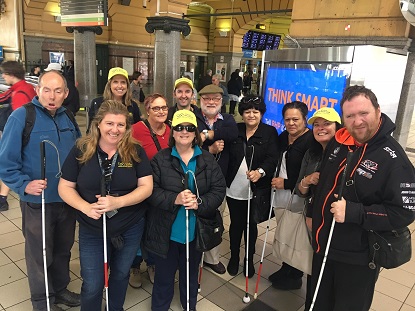Vision Australia and the wider blindness and low vision community have come together to acknowledge the impact white canes have on the lives of people with vision loss.
Today, Sunday, 15 October, is International White Cane Day and Vision Australia is this year celebrating all that white canes support people who are blind or have low vision to do.
A symbol of independence for many from the blind and low vision community, white canes play an important part in supporting their users to be active and independent, whether it’s at home or further abroad.
“People who are blind or have low vision are no different to anybody else in that they want to be active and independent and experience what their surroundings have to offer,” Michael Simpson, Vision Australia General Manager NSW and ACT Client Services.
“That could be a walk to their local shop or café, or it could be undertaking the trip of a lifetime to the other side of the world. Whatever it is, for many people who are blind or have low vision, it’s their white cane and their orientation and mobility skill that allows them to do that,” Mr Simpson said.
Vision Australia recently asked a number of clients where their white cane has taken them and the leading blindness and low vision service provider received a number of interesting responses.
“I think there might be a bit of a perception that people who are blind or have low vision aren’t going to visit places like sighted people do, but our clients told us of visiting places like Alcatraz, Egypt, the Great Wall of China and a lot more. Just because somebody can’t take in the visual elements that somewhere has to offer doesn’t mean they can’t experience it in other ways,” Mr Simpson said.
“We had clients tell us how their white cane had allowed them to do things like march in an anti-Vietnam War protest or herd cattle. It’s amazing just how much of a difference the humble white cane can make in the lives of people who are blind or have low vision.”

While white canes do allow many people who are blind or have low vision to be active and independent, many Vision Australia clients said they still encounter challenges when it comes to navigation.
“Of the hundreds of clients we spoke to, nearly 97% said they encounter obstructions in areas like footpaths. The most common obstruction identified by our clients was furniture from shops and café’s including tables, chairs, sandwich boards and clothes rails,” Mr Simpson said.
“More than 75% of the clients said they had been obstructed by those and we’re calling on businesses, local councils and other stakeholders to ensure they consider the needs of the blind and low vision community when it comes to deciding what is on a footpath.”
For further media opportunities, contact Vision Australia Communications Advisor Phil McCarroll on 02 9334 3308 or 0416 632 253.









